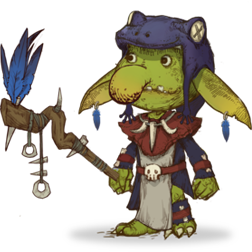Goblin Stone can’t be a Role-playing game without its own set of classes. In this devblog, we will be introducing the goblin classes. What makes goblins interesting is that they do not improve by leveling up. One way to improve them for battle is by carefully choosing their abilities and selectively improving them.
Presently, there are seven goblin classes to choose from when building your adventure party and four more goblin classes in the works. Let’s take a look at the first four classes available in the Goblin Stone demo.
PEON
At the start of the game, players will need to recruit goblins to increase their forces. These come from squatters that visit the lair’s campground or stray goblins encountered during adventures. These unremarkable goblins with little combat skills all start out as the Peon class. Peons may not seem to be the strongest goblin out there, but they can be an essential part of the party that can help increase your inventory space. Their passive ability to carry 50% more loot than any other class is advantageous when players need to forage for more materials or gold.
Peons, however, cannot be equipped with any weapon. They have two default combat abilities which have comparatively low damage compared to the combat abilities of other classes.
ABILITIES
GUARD
“A Goblin of most unwavering bravery, it rescues those in trouble and stuns the foe with its skillful use of Shield”
The Guard’s job is to prevent and soak up damage and protect weaker allies. They have more armor than any other class. Their ability to delay the opponent with powerful stuns can help prevent devastating enemy attacks.
ABILITIES
RAIDER
“Opportunistic and exploitative, the raider bides his time waiting for the right moment to strike.”
The Raider is a very offensive opportunist that capitalizes on units afflicted by status effects. This class works best with other classes that inflict Stun and Bleed. Unlike other classes with a mix of utility and support skills, all of the Raider’s abilities are offensive.
ABILITIES
SHAMAN
“Strength and power borrowed from the spirits of goblins past.”
The Shaman is a supportive character that derives healing powers from communing with ancestors. They also have an impressive range of utility that can delay enemies and bide time for allies to recover. Their strong ties with the spirits also allow them to deal damage when needed.
ABILITIES
There are currently 4 abilities available for the Raider and Shaman class in the Goblin Stone Demo. Similar to the Guard class, each class will have a total of 8 abilities. 4 of which are currently in development and will be available in the Early Access release.
A class is a primary definition of what a Goblin can do during an adventure. Each class is different, and each has its strengths and play style. Some classes may be well suited to adventuring together with other specific classes due to synergies.
Our next post will cover how to change the goblin class and the three new goblin classes we added in our recent demo update. Until then, please share with us your thoughts and feedback!











